Copart's Q1 Miss: A Cyclical Dip or Structural Shift? Here's Why Now is the Time to Buy
The stock market often rewards investors who can distinguish between temporary setbacks and permanent decline.
, Inc.'s (CPRT) Q1 2025 earnings report—where revenue missed estimates but net income rose 6%—presents a classic dilemma: Is this undervalued opportunity or a warning sign? Let's dissect the numbers, operational levers, and macro risks to determine whether Copart's current dip is a buying opportunity.The Q1 Results: A Revenue Setback, Not a Revenue Collapse
Copart's Q1 revenue of $1.21 billion fell short of expectations by $20 million, but this miss was neither catastrophic nor indicative of a structural problem. The shortfall stemmed from two cyclical factors:
1. Uninsured/Underinsured Motorist Trends: A dip in total loss assignments from insurers, which Copart attributes to cyclical fluctuations in accident severity and insurance claims.
2. Heavy Equipment Softness: A segment hit by tariffs and delayed infrastructure spending, particularly in Purple Wave partnerships.
Meanwhile, operational resilience shone through:
- Global service revenue rose 9%, driven by an 18% surge in international sales (Europe and Asia outperformed).
- Net income hit $347 million, up 6% year-over-year, despite the revenue miss.
- Inventory turnover accelerated, with global inventory down nearly 10% due to faster cycle times and reduced low-value unit aged inventory—a direct result of initiatives like Title Xpress, which streamlined title processing.

The Margin Story: Gross Profit Strength Amid Transition
While revenue missed, Copart's gross margin held steady at 46%, a testament to its pricing power and operational efficiency. The CFO noted that one-time adjustments in U.S. purchased vehicle profits did not mask underlying strength. Meanwhile, the shift from purchase contracts to consignment models—though reducing purchased vehicle revenue by 25%—could prove advantageous long-term. Consignment models reduce inventory risk and align with insurer preferences, suggesting a strategic pivot rather than a misstep.
This data will show how Cop's net income has grown steadily despite revenue volatility, reinforcing its profit resilience.
The Cyclical Risks: Storms, Tariffs, and Uninsured Motorist Volatility
The headwinds Copart faces are undeniably cyclical:
- 2025 Hurricane Season: Management has prepared with land acquisitions like Florida's Hull Ranch, but an active storm season could strain capacity and logistics.
- USMCA Compliance: Tariffs and trade policies remain uncertain, though they could boost salvage demand if repair costs rise.
- Uninsured Motorist Trends: A temporary drag on assignment volumes, but these are historically cyclical and tend to rebound.
Valuation: A Stock at a 52-Week Low—But Is It a Bargain?
At $59.25 post-earnings, Copart's stock trades near its 52-week low, within its range of $59.25–$64.38. Analysts' target price of $56–$69 suggests it's already near the lower end of expectations. Key valuation metrics:
- P/E Ratio: ~14x trailing EPS, below its 5-year average of ~16x.
- EV/EBITDA: ~10x, a discount to peers like Carvana (though Copart's business is far more stable).
- Balance Sheet: $5.6 billion in liquidity, including $4.4 billion in cash—a fortress-like position to weather downturns.
Why This Is a Buying Opportunity
- Structural Growth Drivers Remain Intact:
- Global Expansion: International revenue grew 18%, and Copart's land bank (like Florida's Hull Ranch) positions it to capitalize on rising disaster-related salvage demand.
- Blue Car & Fleet Services: Up 14% YoY, proving non-insurance revenue streams are thriving.
Operational Leverage: Strong inventory management and cost controls have maintained margins even in a weak quarter.
Cyclical Headwinds Are Temporary:
- Uninsured motorist trends will normalize.
- Heavy equipment softness is tied to macro delays, not Copart's execution.
Storm preparedness investments will pay off if 2025's hurricane season is active, which could boost revenue in coming quarters.
Undervalued on a Long-Term Basis:
Copart's stock has underperformed the S&P 500 by 15% over the past year, despite its fortress balance sheet and 9% YoY service revenue growth. At ~14x earnings, it's a discount to its own growth trajectory.
The Recommendation: Buy the Dip
Investors should view Copart's Q1 miss as a buying opportunity. The revenue shortfall is cyclical, not structural, and the company's infrastructure investments, strong liquidity, and margin resilience position it to rebound strongly. Historically, when Copart reported a revenue miss alongside rising net income, a 12-month holding period delivered an average return of 16.27%, according to backtests from 2015 to 2024. While the strategy experienced a maximum drawdown of 16.61%, the results suggest that such dips have historically been recovered over time.
Entry Point: The current price of $59.25 is near the 52-week low, offering a margin of safety.
Target: A return to the $60–$65 range (within its historical range) seems reasonable in 6–12 months, with upside to $70 if storm seasons or tariff-driven salvage demand surge.
Final Take
Copart isn't just a play on cyclical recovery—it's a long-term bet on its dominance in salvage auctions, infrastructure scale, and the inevitability of natural disasters and vehicle total losses. This dip isn't a red flag; it's a green light for investors to buy a high-quality business at a discount.

Comments
No comments yet